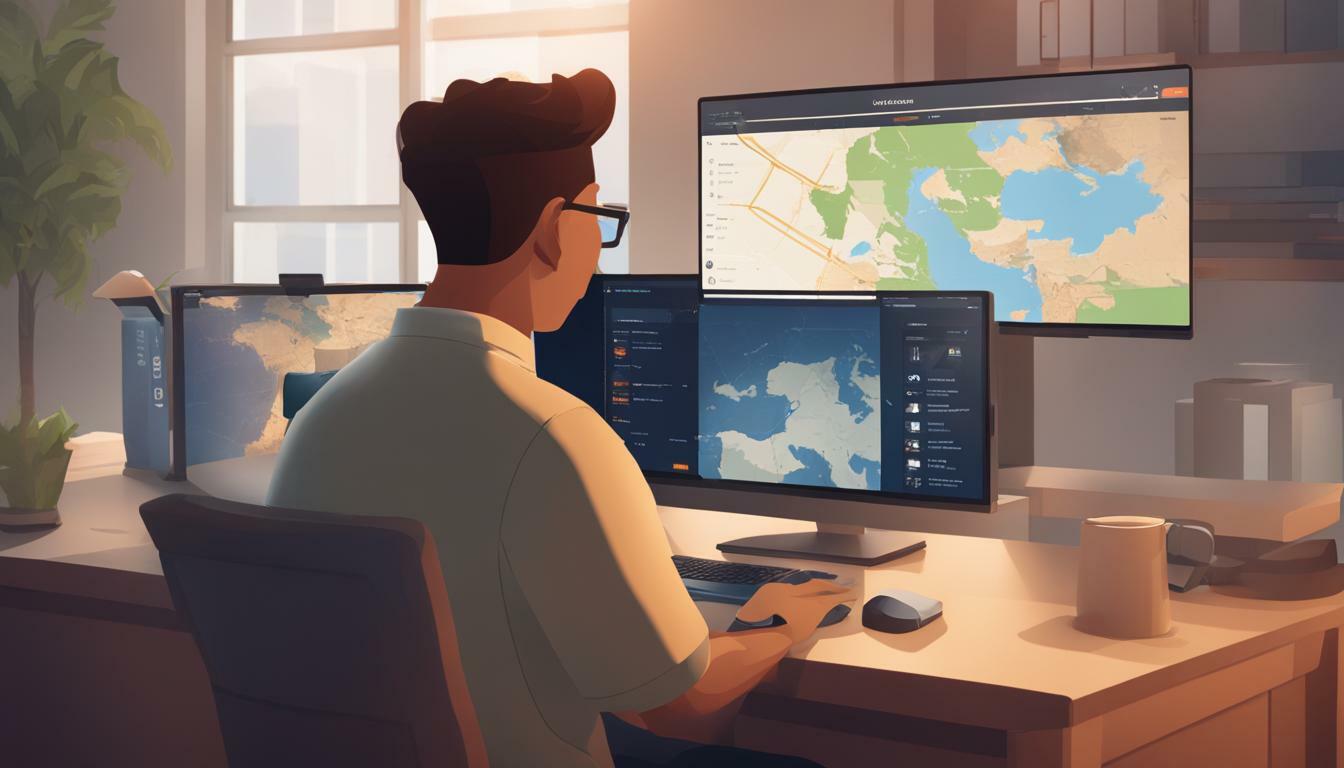Are you looking to access geo-restricted content or browse the internet as if you were in a different location? A Virtual Private Network, or VPN, can be a game-changer. With a VPN, you can navigate the online world while hiding your real IP address and location. In this section, I will walk you through the steps to effectively use a VPN to change your location and access content that may be unavailable in your area.
Key Takeaways
- Using a VPN is an effective way to change your virtual location and access geo-restricted content.
- A VPN allows you to browse the internet while maintaining your online privacy and security.
- Selecting a reliable VPN service provider is crucial for a seamless and secure experience.
- By following the steps outlined in this article, you can easily install and configure a VPN on your device.
- After connecting to a VPN server, verifying your new location and accessing geo-restricted content is simple.
Understanding VPN and Its Benefits
Before I delve into the steps of changing your location with a VPN, let me first explain what a VPN is and its benefits. A VPN or Virtual Private Network is a technology that encrypts your internet connection and routes it through a server located elsewhere. By doing so, a VPN masks your IP address and makes it appear as if you are accessing the internet from a different location.
One of the primary advantages of using a VPN to change your location is enhanced online privacy. When you connect to a VPN, your online traffic is encrypted, and your internet service provider (ISP) cannot monitor or track your activity. Additionally, a VPN allows you to bypass censorship and access websites that may be blocked in your country or region.
Another significant benefit of using a VPN to change your location is the ability to access region-locked websites and services. For example, if you want to watch a show that is only available on Netflix US but you reside in another country, you can use a VPN to change your virtual location and access the content.
To sum up, using a VPN to change your location offers several benefits, including enhanced online privacy, bypassing censorship, and accessing region-locked websites and services. Now that we’ve covered the basics, let’s move on to the steps to use a VPN to change your location.
Choosing a Reliable VPN Service Provider
Relocating with a VPN requires selecting a trustworthy service provider. With numerous options available, it’s crucial to consider several factors to ensure a seamless and secure experience. Here are some things to keep in mind when choosing a VPN for changing your IP address:
| Server Locations | Make sure the VPN provider has servers in the regions you wish to relocate to. The more server locations, the better the chances of finding a suitable server with faster connection speeds. |
|---|---|
| Encryption Protocols | The VPN should use robust encryption protocols to ensure your data remains secure during transmission. Look for providers that use AES-256-bit encryption, which is currently the strongest available. |
| Connection Speed | Since VPNs can slow down your internet connection, it’s essential to choose a provider with fast servers. Providers often offer speed tests to determine the best server locations for optimal performance. |
| User-Friendly Interfaces | The VPN software should be easy to use, even for beginners. Look for providers with intuitive interfaces, clear instructions, and responsive customer support. |
By choosing a reliable VPN service provider, you can enjoy the benefits of changing your virtual location with ease and confidence.
Installing and Configuring Your VPN
Now that you’ve chosen a reliable VPN service provider, it’s time to install and configure the VPN software on your device. The process may vary slightly depending on the VPN provider you’ve selected, but the general steps to install and configure your VPN remain consistent.
Selecting appropriate server location and protocols
Before connecting to a VPN server, it’s important to choose an appropriate server location and protocol to change your IP address. Some VPN providers may suggest a particular server location and protocol based on your intended use, while others may give you the freedom to choose.
To change your IP address effectively, select a server location that matches the virtual location you want to use. For instance, if you want to access content that is only available in the UK, connect to a server location in the UK. Similarly, if you want to appear as if you’re browsing from Japan, connect to a server location in Japan.
Most VPN providers offer a range of protocol options such as OpenVPN, L2TP/IPSec, and PPTP. OpenVPN is known for its security and speed, while L2TP/IPSec is recognized for its strong encryption. PPTP is generally considered to be the fastest protocol option but lacks the security features of other protocols.
Once you’ve selected the server location and protocol, install and configure the VPN software on your device.
Installing and configuring your VPN software
- Log in to your VPN account and download the VPN software.
- Follow the instructions provided by the VPN provider to install the software on your device.
- Launch the VPN software and log in using your credentials.
- Select an appropriate server location and protocol.
- Connect to the VPN server.
- You should now be connected to the VPN and have changed your IP address.
It’s worth noting that some VPN providers offer browser extensions that allow you to change your virtual location without installing and configuring the full VPN software on your device. Browser extensions can be a convenient option for users who only need to change their location for specific websites or applications.
However, browser extensions may not provide the same level of security and anonymity as the full VPN software. Consider your security and privacy needs before choosing a browser extension over the full VPN software.
Now that you’ve installed and configured your VPN software, it’s time to connect to a VPN server.
Connecting to a VPN Server
Now that you have your VPN configured, it’s time to connect to a server. This is where the VPN magic happens, switching your device’s IP address to a location of your choosing. Here’s how you can connect to a VPN server:
- Open your VPN app and sign in.
- Select a server location that you want to connect to. You can usually choose from a list of countries, cities, or specialized servers such as dedicated streaming servers.
- Click on the connect button. This will initiate the connection to the server location and establish a secure connection to the internet.
It’s important to note that some VPNs offer options beyond just selecting a server location. Advanced users may want to choose a specific protocol or enable additional features such as a kill switch or split tunneling. If you’re unsure about any of these settings, consult your VPN provider’s documentation or support resources.
VPN Location Switcher
If you want to switch to a different server location while connected to a VPN, simply disconnect from your current location and select a new one. Depending on your VPN, this process may involve clicking a button or selecting a new server location from a dropdown menu.
It’s important to note that changing server locations may affect your connection speed or cause a brief interruption in your internet connection. If you’re experiencing performance issues, try connecting to a different server location or consult your VPN provider’s support resources for troubleshooting tips.
Verifying Your New Location
After establishing a connection to a VPN server, it’s crucial to confirm that your location has, indeed, changed. There are various methods to do this, and the easiest is to use an IP geolocation tool. These tools will display your new IP address, location, and other related information. You can find many free IP geolocation tools by conducting a web search.
Another effective way to verify your new location is to access region-specific websites or streaming platforms. For instance, if you’re trying to access a streaming service that is only available in the United Kingdom, connect to a UK-based VPN server and try to access the service. If you can access it with ease, then you have indeed changed your location.
Accessing Geo-Restricted Content
Changing your location with a VPN opens up a world of possibilities in terms of accessing geo-restricted content. Whether you want to watch your favorite show on a foreign streaming platform or access region-specific news websites, a VPN can make it happen.
Once connected to a VPN server, you can browse the internet as if you were in the location of the server. This means you can access websites and services that are typically unavailable in your physical location.
Popular streaming platforms like Netflix and Hulu have different content libraries for each country, and using a VPN can allow you to access the full range of content available in different regions. This can provide a significant boost to your entertainment options, allowing you to discover new movies, TV shows, and documentaries that were previously unavailable in your area.
Additionally, a VPN can help you circumvent censorship and access websites and services that are restricted in your country. This can be particularly useful for travelers or expats who need to access websites or services that are only available in their home country.
However, it’s worth noting that some streaming platforms and websites actively block VPN traffic. This means that even if you’re connected to a VPN, you may not be able to access certain content. If this is the case, try connecting to a different VPN server or using a different VPN provider.
Ensuring Privacy and Security
When using a VPN to change your location, it’s crucial to also prioritize your online privacy and security. Here are some important features of a VPN that can help safeguard your data:
- Encryption: A reliable VPN employs state-of-the-art encryption protocols to protect your data from cyber threats and data breaches. This ensures that your online activities remain private and secure.
- Anonymity: By using a VPN, you can mask your IP address and online identity, making it difficult for third parties to track your online behavior and personal information.
- Preventing ISP tracking: Using a VPN prevents internet service providers (ISPs) from tracking your online activities, enabling you to browse the internet freely without the risk of targeted advertisements or data collection.
By understanding these key features, you can ensure a secure browsing experience while exploring different virtual locations. It’s important to select a VPN provider that prioritizes privacy and security.
Troubleshooting and Tips
While using a VPN to change your location, you may encounter some issues or have specific questions that need answers. Below are some useful tips to enhance your VPN experience and resolve common problems.
Check for Software Updates
One of the primary reasons for VPN issues is outdated software. Make sure to check your VPN provider’s website for software updates regularly. Updating your software ensures that you have access to the latest features, bug fixes, and security enhancements.
Change Server Location
If you’re experiencing issues with your VPN connection, try changing the server location. Some servers may be more overloaded than others, resulting in slow connection speeds. By switching to a different server, you can improve your connection quality and enjoy a smoother browsing experience.
Check your Internet Connection
Before resorting to troubleshooting your VPN, make sure that your internet connection is stable and strong. Weak or unstable connections can cause VPN connection issues and affect your browsing experience.
Disable Firewall or Antivirus
If you’re having trouble connecting to your VPN, try disabling your firewall or antivirus temporarily. Sometimes, these programs can interfere with your VPN connection and prevent you from connecting to a server. Once you’ve connected, you can re-enable your firewall or antivirus for added security and protection.
Contact your VPN Provider
If you’ve tried all the troubleshooting tips above and are still experiencing issues with your VPN, it’s time to contact your VPN provider’s customer support. They can offer more personalized and detailed assistance, addressing specific problems and answering your questions.
Staying Up to Date with VPN Technology
As technology evolves, so do VPNs. It’s essential to stay up to date with the latest updates and features to optimize your VPN experience. It’s especially important to keep an eye out for any potential vulnerabilities that could compromise your online security.
One way to stay informed is by joining online communities or forums dedicated to VPN usage. These platforms often provide insights into the latest VPN technology and user experiences, allowing you to learn from other people’s experiences and stay up to date with the latest trends.
Another way to stay informed is by signing up for your VPN provider’s newsletters or email notifications. This way, you’ll receive updates on any changes or new features to the VPN software, ensuring you’re always informed and never miss out on any developments.
Additionally, it’s important to update your VPN software regularly. New updates often provide bug fixes or enhance security features, ensuring optimal performance and protection while changing your location.
- Stay informed by joining online communities and forums
- Sign up for your VPN provider’s newsletters and notifications
- Regularly update your VPN software for optimal performance and protection
By staying informed and keeping your VPN up to date, you can ensure that changing your location remains a safe and enjoyable experience.
Exploring VPN Alternatives
While VPNs are widely used and considered reliable, there are other techniques and tools available to change your location. Here are some alternatives to VPNs:
- Proxy Servers: Proxy servers act as intermediaries between your device and the internet. By routing your internet traffic through a proxy server, you can change your IP address and access geo-restricted content. However, proxies are not as secure as VPNs since they don’t encrypt your data and may leak your information.
- Tor: Tor (or The Onion Router) is an anonymity network that masks your IP address by bouncing your internet traffic through different servers around the world. While Tor is excellent at providing anonymity, it’s not suitable for streaming or accessing content that requires a stable connection.
It’s worth noting that VPNs remain the most widely used and reliable method for changing your location and accessing geo-restricted content. However, exploring alternative options can help you find the best solution for your specific needs.
Conclusion
In this article, I have explored the steps to use a VPN to change your location, the benefits of using a VPN, and how to choose a reliable VPN service provider.
We have also covered installing and configuring your VPN, connecting to a VPN server, and verifying your new location. Additionally, we discussed accessing geo-restricted content, ensuring privacy and security, troubleshooting and tips, and staying up to date with VPN technology.
By following the steps outlined in this article, you can navigate the digital world freely and securely. Remember to choose a reputable VPN service provider, follow best practices for online security, and stay informed about VPN technology updates.
Using a VPN to change your location presents numerous benefits, from unlocking region-specific content to enhancing your online privacy and security. Embrace the power of a VPN and unlock a world of possibilities.
FAQ
Q: How does a VPN change my location?
A: A VPN allows you to change your location by routing your internet connection through a server in a different geographic location. This masks your true IP address and makes it appear as if you are browsing from the server’s location.
Q: Why would I want to change my location using a VPN?
A: Changing your location with a VPN can give you access to geo-restricted content that is otherwise unavailable in your region. It also allows you to bypass censorship, enhance your online privacy, and protect your data from prying eyes.
Q: How do I choose a reliable VPN service provider?
A: When choosing a VPN service provider, consider factors such as server locations, encryption protocols, connection speed, and user-friendly interfaces. Look for providers with a solid reputation, good customer reviews, and a strong commitment to privacy and security.
Q: How do I install and configure a VPN?
A: To install and configure a VPN, you need to download the VPN software provided by your chosen VPN service provider. Follow the installation instructions and then customize the settings according to your preferences, such as selecting server locations and encryption protocols.
Q: How do I connect to a VPN server?
A: To connect to a VPN server, open the VPN software on your device and enter your login credentials. Then, choose a server location and click the “Connect” button. The software will establish a secure connection to the chosen server, changing your virtual location.
Q: How can I verify that my location has changed?
A: You can verify your new virtual location by using IP geolocation tools, visiting region-specific websites or streaming platforms, or checking your IP address. These methods will confirm that your connection is now routed through the VPN server and your location has changed.
Q: How can I access geo-restricted content using a VPN?
A: Once connected to a VPN server, you can access geo-restricted content by visiting websites or streaming platforms that are only available in specific regions. The VPN will make it appear as if you are browsing from the desired location, granting you access to the restricted content.
Q: How does a VPN ensure my privacy and security?
A: A VPN protects your privacy and security by encrypting your internet traffic, making it unreadable to anyone attempting to intercept it. It also masks your IP address, making it difficult for others to track your online activities. Additionally, a VPN prevents your internet service provider (ISP) from monitoring your browsing habits.
Q: What should I do if I encounter issues with my VPN?
A: If you encounter issues with your VPN, first try disconnecting and reconnecting to the VPN server. If the problem persists, check your internet connection, ensure you have the latest version of the VPN software, and contact your VPN service provider’s customer support for assistance.
Q: Are there alternative methods to change my location?
A: Yes, there are alternative methods such as using proxy servers and the Tor network. These methods have their own unique features and use cases, so it’s worth exploring them to determine the most suitable option for your specific needs.








